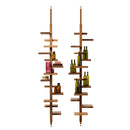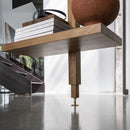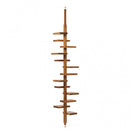Description
The Adelaide etagere is designed by the designer Claudio Bitetti for Mogg. The structure is available in Iroko solid wood or in matt black iron. It is complete with 13 shelves, prepared for fixing to the ceiling (ceiling height from 236 cm to 302 cm).
It is an elegant bookcase, forced between floor an ceiling with a vertical stick qith square section where are fixed asymmetrically on the 4 sides the shelves of two different sizes (20x30 cm, 25x30 cm). It is an element that can be used as a partition, as a bookcase able to personalize any environments also of the corners.
Specify in the order the length of the upper end-part (A-B-C) according to the height of your ceiling.
Product Dimension
Width: 55 cm
Depth: 55 cm
Height: 236/302 cm
Technical Scheme

Inspiration
Adelaide comes from the Germanic Adalheidis, composed of the roots adal ("noble", "nobility") and heid ("lineage", "family", "type", "quality", "way of being"); its meaning can be interpreted as "of noble stock", "of noble manners", or "of noble appearance. What better choice for this elegant bookcase, terra cielo, made of both wood and iron, composed of a square-based column, swiveling, to which 13 shelves of two different sizes are fixed in an asymmetrical manner on the 4 sides, to confirm that , if in a system the disorder (entropy) progressively increases when it reaches a certain critical threshold, it suddenly decreases and the system is reborn in a new order.
Designer
Born in Aosta 1962, He got his graduation in Industrial Design at the Politecnico University of Milan-Department of Architecture. He works for some furniture industries among which Alivar, Ciatti a Tavola, Dilmos,EmmeBi, Minottiitalia , Mogg, Movelight, Sturm Und Plastic, and he also projects shops and private houses. His approach to projecting passes through concepts like flexibility, forms dynamism and breaking up at minimal terms, empowered by an aesthetic idea which looks for the poetical form of the object without debasing its recognisability and functional effectiveness. As Elio Franzini, professor of Aesthetics at the State University of Milan, wrote: “Bitetti’s forms, within the projectual (and physical) I-We dialogue, are then symbols; they have an open meaning, the invisible acting through the visible”.So, looking for a different sense of things, going over the traditional idea of their use, Claudio Bitetti gives “a repertoire of projects passing through the home space, making the people who live it to exploit the whole of their senses, to use double-senses, to elaborate common-sense”, as affirmed by Flaviano Celaschi, professor and vice-dean of the Milan Faculty of Industrial Design.
Pre Order Sales Conditions
Payment & Security
Your payment information is processed securely. We do not store credit card details nor have access to your credit card information.














